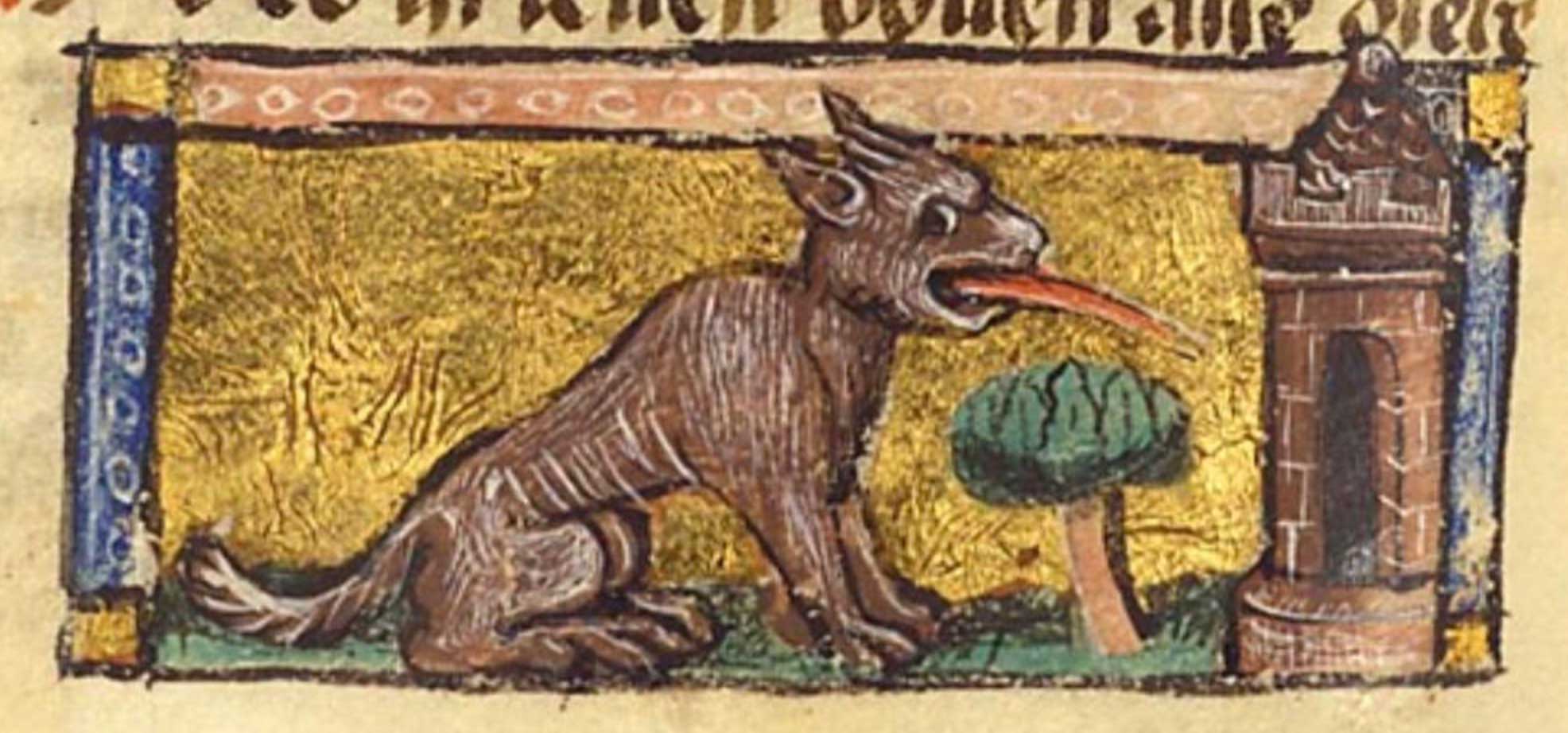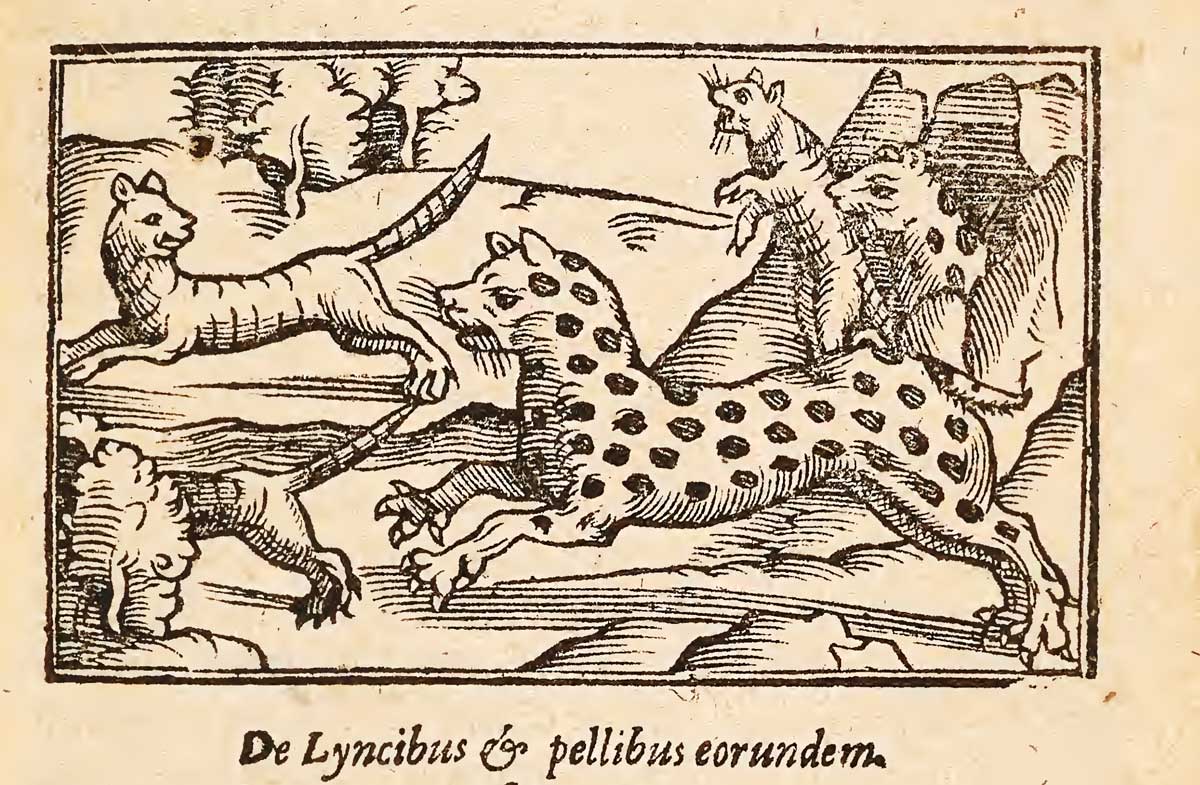which treachery was by Ceres transformed into an ounce, or loupcervier.
Original French: laquelle trahiſon feut par Ceres transformé en Oince, ou Loupceruier.
Modern French: laquelle trahison feut par Cerès transformé en Oince, ou Loupcervier.
Notes
Lynx

Linx (lynx)
Fol. 23vb2: column miniature
Lyncibus
oince
5.660 lynca Ceres fecit
5.642 Then the goddess of fertility yoked her two dragons to her car, curbing their mouths with the bit, and rode away through the air midway between heaven and earth, until she came at last to Pallas’ city. Here she gave her fleet car to Triptolemus, and bade him scatter the seeds of grain she gave, part in the untilled earth and part in fields that had long lain fallow. And now high over Europe and the land of Asia the youth held his course and came to Scythia, where Lyncus ruled as king. He entered the royal palace. The king asked him how he came and why, what was his name and country: he said: “My country is far-famed Athens; Triptolemus, my name. I came neither by ship over the sea, nor on foot by land; the air opened a path for me. I bring the gifts of Ceres, which, if you sprinkle them over your wide fields, will give a fruitful harvest and food not wild.” The barbaric king heard with envy. And, that he himself might be the giver of so great a boon, he received his guest with hospitality, and when he was heavy with sleep, he attacked him with the sword. Him, in the very act of piercing the stranger’s breast, Ceres transformed into a lynx; and back through the air she bade the Athenian drive her sacred team.’
Loup-cervier
Loup-cervier: A kind of white Wolfe, or beast ingendred betweene a Hind and a Wolfe, whose skinne is much esteemed by great men; yet some (not beleeving that those beasts will, or can mingle) imagine it rather to bee the spotted Linx, or Ounce; or a kind thereof.
Oince
Oince: A Hawkes Pounce; (and thence) a hooke; and (as in Rab.) a hand, or fist; also, the beast called an Ounce, or Linx.
Lyncus
Pour lynx, par le retranchement de l’l initiale, comme si c’étoit l’article le contracté avec le nom. Nous avons déja trouvé cette leçon plus haut.
ounce, loupcervier
Leuzerns, Luzarnes, Lucern. A fur mentioned in the wardrobe accounts of Henry VIII. Cotgrave has, “A luzarne: loupcervier,” and under the latter word says, “a kind of white wolfe, or beast ingendred between a hind and a wolf, whose skin is much esteemed by great men; yet some (not believing that those beasts will or can mingle) imagine it rather to bee the spotted linx or ounce, or a kind thereof.” Luzarne is probably a corruption of loupcervier. The fur might be that of the lynx or ounce, but wolf’s fur is mentioned in wills and inventories of the sixteenth century, and that of a white wolf, perhaps, was considered a rarity. In a parliamentary scheme, dated 1549, it was proposed that “no man under the degree of an earl be allowed to wear luzarnes.” (Halliwell, in voce “Lucern.”) “Item, for making of a shamew of blacke printed satin, embroidered with damaske golde, and furred with luzardis of our stores, the bodies and sleeves lyned with buckram of our gt wardrobe.” (Wardrobe Acccount, 28 June, 8th Henry VIII, 1516.)
Ounce or Stag-Wolf
Ovid, Met, v. 642-661.
oince
Voir Ovide, Métamorphoses, V., v. 642-661
oince ou loupcervier
Lynx ou loup-cervier, nom donné aux diverses espèces de Lyncs (Lynchus). Mais le nom de loup-cervier a été également appliqué, par confusion, à la panthère (Felis pardus, L.), au guépard (Cynailurus jubatus, Erxl.) et à l’irbis (Felis unica, Schreb.) « Loups-cerviers et onces qu’on nomme autrement Linces» dit Pierre Belon, Les observations de plusieurs singularitez et choses mémorables trouvées en Grèce, Asie, Judée, Égypte, Arabie et autres pays estranges, l. I, ch. 76.
Ceres
Ovide, Métam, V, 642-601 (EC).
transformé en Oince, ou Loupcervier
Ovide, Métamorphoses, VI v.642-661.
loup cervier
loup cervier [French loup cervier, adaptation of Latin lupus cervarius (Pliny) the lynx (lupus wolf, cervarius that hunts stags, formed on cervus stag).] The Canada lynx (Lynx Canadensis), a species of wild cat with a short tail.
1725 Coats Dict. Heraldry, Loup-cervier is a very large Sort of Wolf.
1744 A. Dobbs Hudson’s Bay 41 The Loup Cervier, or Lynx, is of the Cat Kind.
ounce
ounce. Forms: unce, once, owns, onse, ounce.
[adaptation of Old French once (13th century in Littré), lonce (Voyages de Marc Pol, Godefroy Compl.). Old French l’once (according to Hatzfeld and Darmesteter, Dictionnaire général de la langue française) represents an earlier lonce (the l being confounded with the definite article) : -popular Latin type *luncia, for Latin lyncea, deriv. of lync-em lynx.]
A name originally given to the common lynx, afterwards extended to other species, and still sometimes applied in America to the Canada lynx and other species. From 16th c. applied to various other small or moderate-sized feline beasts, vaguely identified.
13… K. Alis. 5228 Bores, beres, and lyouns,… Vnces grete, and leopardes.
C. 1470 Henryson Mor. Fab. v. (Parl. Beasts) xvi, The wyld once, the buk, the welterand brok.
A. 1586 Sidney Arcadia iii. Wks. 1724 II. 715 The lion heart, the ounce gave active might.
1590 Shakespeare Mids. N. ii. ii. 30 Be it Ounce, or Catte, or Beare, Pard, or Boare with bristled haire.
1598 B. Yong Diana 91 The pillers were supported with Lyons, Ounces and Tygres,… cut of brasse.
1601 Holland, translator Pliny xxviii. viii. II. 316 The Onces be likewise taken for strange and forrein, and of all foure-footed beasts they haue the quickest eie and see best [Latin Peregrini sunt et lynces, quæ clarissimi quadrupedum omnium cernunt].
1607 Topsell Four-Footed Beasts (1658) 380 The wilde beast which among the Germans is named Luchss (by making a name from the Linx… the Spaniards do as yet call him by the Latin name Lince… amongst the barbarous writers he is called by the name of an Ounce (which I do suppose to be a panther).
1648 Gage West. Ind. xii. (1655) 45 (Montezuma’s Palace) Great cages… wherein were kept in some Lions, in other Tygres, in other Ownzes, in other Wolves.
1662 Stillingfl. Orig. Sacr. iii. iv. §7 Such as differ in size and shape from each other, as the Cat of Europe, and Ownce of India.
1667 Milton Paradise Lost iv. 344 Tygers, Ounces, Pards Gambold before them.
1672 Josselyn New Eng. Rarities 16 The Ounce or Wild Cat, is about the bigness of two lusty Ram Cats.
In current zoological use: A feline beast (Felis uncia), inhabiting the lofty mountain ranges of Central and Southern Asia; it resembles the leopard in markings, but is smaller and of lighter ground colour, and has longer and thicker fur; also called mountain-panther and snow-leopard.
[1607 Edward Topsell The history of foure-footed beasts and serpents (1658) 381 Ounces do commonly seem to be called rather Linxes then Panthers; but although some late writers do attribute the name to a Leopard or a lesser Panther, it seemeth notwithstanding corrupt from the Linx. ]
[1761 Buffon Hist. Naturelle IX. 152 La seconde espèce est la petite panthère d’Oppian… que les Voyageurs modernes ont appelé, Once du nom corrompu Lynx ou Lunx. ]
1843 Sir W. Jardine in Naturalist’s Libr. III. 192 The ounce is first noticed by Buffon.
Applied to the Cheetah or Hunting Leopard: this being at first confounded with the Ounce of Buffon. Obsolete
1694 in Churchill’s Voy. (1704) IV. 162 Besides Hawks and Dogs, they make use of a sort of Creatures they call Onses, about the bigness of a Fox, very swift, their Skins speckled like Tigers, and so Tame, that they carry them behind them on Horse-back.
1706 Phillips, Ounce, is also a kind of tame Beast in Persia, mistaken for a lynx.
1801 Southey Thalaba ix. xviii, And couchant on the saddle-bow, With tranquil eyes and talons sheathed, The ounce expects his liberty.
1821 Shelley Prometh. Unb. i. i. 609 As hooded ounces cling to the driven hind.
Attributive and combinations: ounce-stone, a rendering of Pliny’s lyncurium, a reputed precious stone, now understood to have been amber. Obsolete.
C. 1505 Mem. Ripon (Surtees) III. 196 Et de 13s. 5d. ex mutacione argenti… pro owns taylles.
1583 Rates of Customs D v b, Ounce skinnes the peece xs.
1601 Philemon Holland, translator Pliny’s History of the world, commonly called the Natural historie II. 609 That the Once stone or Lyncurium is of the same colour that Ambre ardent which resembleth the fire.
1833 Ht. Martineau Charmed Sea iv. 44 Mouse, ounce, and hare skins may serve us at present as well as sables could do.
